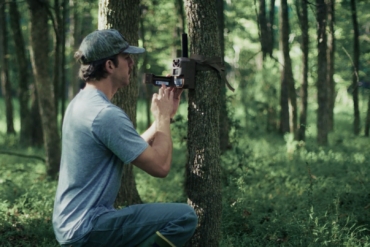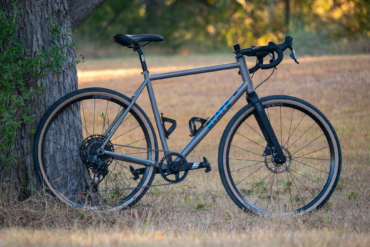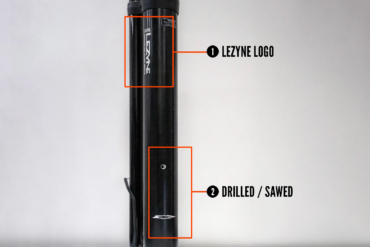Despite your best efforts, the most efficient mountain bike tire pressure for you will be a compromise. We spoke with one of the world’s foremost tire experts to learn how to get the most from your treads.
The range of forces applied to tires and the variety of substrates you ride over make any tire pressure level a banker’s scale. You give up a bit here to gain a bit there.
My quest for the most efficient tire pressure started when I spent more time on dirt than pavement. There were times when I felt my pressures were spot on. I enjoyed low rolling resistance, great bump absorption, and grip when needed.
So in an effort to replicate that sensation on every ride, I invested in a digital pressure gauge. This sent me down a rabbit hole, meticulously tweaking tire pressure for a given ride. The end result was a set of tires that performed optimally more often than not.
There are several factors that go into an ideal pressure setup. But with time, tools, and some know-how, you can dial in your tires for the perfect ride. And that bit of due diligence can improve anyone’s day on the trails.
Tire Pressure Physics
Few people on the planet know more about bicycle tires than Wolf Vorm Walde. As the former head of Research and Development for Continental Tires, and now Specialized’s Director of Tires and Tubes in Germany, Vorm Walde and his team are constantly tweaking commercial stables of tires.
According to Vorm Walde, the function of a pneumatic tire is to “carry the load of bike and rider [and] provide comfort and adherence to the ground.”
By adjusting air pressure, riders influence the tire casing more than any other bike component.
“A tire casing is basically a canister,” Vorm Walde said. “And because its walls are a flexible membrane, it works like an air spring and provides suspension.”
Vorm Walde said riders essentially dial in spring preload by adjusting tire inflation. Lower pressure equals lower tension, and higher pressure equals higher tension — and therefore a greater load-carrying capacity.
“A light rider gets away with lower pressure for the same firm ride feel a heavy rider would need a couple extra pump strokes for,” he said. “For the same tire size, we need to pick different inflation pressure for different rider weights.”
It turns out that this conversation is less about tire pressure and more about casing tension. Most of us lack an ASTM or ISO lab to test casing tensions, but we can draw parallels with the amount of pressure that reads on tire gauges.
How to Find the Tire Pressure ‘Sweet Spot’
The trick with mountain biking — or any riding on a varied surface — is to find the tire pressure sweet spot for your weight.
According to Vorm Walde, as casing tension decreases, “lower casing tension lets the tire deform more under the same load. The footprint of the tire gets larger. It can conform to the ground better. This means more traction. More tread area is in contact with the ground. Second, the tire can follow and level the contours of the ground better.”
Too little casing tension and the tire feels squirmy, lacks feedback, costs energy, will likely burp air out, and could catastrophically damage your rim. If there’s too much casing tension, the bike and rider are lifted instead of the tire deforming, again costing energy.
Get These Tools
To take reasonably accurate measurements you need reasonably accurate tools. I initially thought that spending $40 on a pressure gauge was excessive. But after day one, it became indispensable.
My biggest revelation came when verifying tire pressure on my stack of floor pumps with analog gauges. I found that the analog gauges were off by a lot — as much as 25 percent. I also found that a digital gauge with a bleed valve can really dial in pressure — pound per square inch by pound per square inch.
And with big numbers displayed on a digital screen, instead of picking a slot someplace between 15 and 20 pounds, I know exactly what my tire pressure is. Plus, unlike digital gauges that directly measure a tire’s pressure, floor pumps provide a pressure reading of the tire and hose once a significant amount of air has filled it.
Conduct a Roll-Out Test
How do we make this information actionable? With a roll-out test. At the most basic level, you will need a stopwatch, a digital pressure gauge, and some tape, cones, or a stick in the ground to mark the start/finish of your course.
Look for a gradual downhill run over several hundred meters of terrain that’s consistent with the terrain you typically ride. In my case, I ride long loops that involve Forest Service roads and singletrack. My test run is a slight downhill of gravel road leading to singletrack. Its total length is about 500 meters.
First, inflate your tires to a few psi over the manufacturer’s maximum recommended tire pressure. Mark your course. Ride your bike a bit to get the tires warmed up before your first run. Then bleed the tire pressure down to the manufacturer’s maximum recommended tire pressure with your gauge’s bleed feature. Take a run, record your time, and record the tire pressure you started with.
Second, repeat while lowering psi. From this point forward, your goal will be to take identical runs. Focus on laying your tracks down on top of your last run so that your line is the same, and maintain an identical body position. Wind will have an influence on results, so a light-wind day is ideal.
As per Vorm Walde, Specialized bleeds down in 0.2 bar (approximately 3 psi) increments for 2.1- and 2.3-inch tires.
Record your times for each run while gradually lowering tire pressure. Note that in your first few runs, especially if you are lighter weight, you will likely not see any time differences. Keep doing what you’re doing — you’ll hit a tipping point where your tires don’t bounce you and your bike, instead becoming more compliant and forming to the ground.
At that point, your times will drop. Continue making runs until a pattern has formed and your lowest time has been established. Congrats, you’ve found your sweet spot!
Do the Math
If you have a watt meter, you can also do the same on a loop course, applying as close to identical power from one run to another. Care should be taken so that the course doesn’t have any significant uphills or downhills, as applying consistent power on those variances will be challenging.
Once you have your theoretical most efficient tire pressure, carry that info from one tire cross section diameter to another by applying Barlow’s Formula: (T)ension = (P)ressure x (D)iameter.
If one switches from 27.5-inch to 29-inch tires, there’s little in the way of an established and consistent relationship.
“The bigger wheel diameter brings with it a shallower impact angle of the tire to the ground,” Vorm Welde said. “Which means the twist and tension in the casing in and around the footprint area is less. However, we don’t see a significant enough influence to recommend different tire pressures for different wheel sizes.”
What we don’t touch on is the relation between tire pressure and frame suspension. Tire pressure and suspension adjustment need to be addressed in tandem. One does not work properly without the other, but that’s a topic for another discussion.
This Is the Start, Not the Finish
Your sweet spot tire pressure is just your baseline. You also have to consider differences in tire pressure between the front and rear tires. If you race XC, that relationship could be very different from a downhill racer.
Then there are environmental factors, specifically temperature and elevation. To see what effect solar radiation plays on tire pressure, I put a 29-inch wheel, outfitted with a 2.3-inch tire, in the yard on a sunny Colorado day. Nighttime temps were in the 40s.
At 6:00 a.m., the surface temperature of the tire was 46.4 degrees Fahrenheit (per a laser thermometer). By mid-afternoon, tire surface temperature was 139.1 degrees Fahrenheit, and the tire pressure had increased by 71 percent.
On a recent ride, again on a typical sunny Colorado day, I started out at 7,500 feet and topped out about 90 minutes later at 10,680 feet. The tire pressure increased by 46 percent. By carrying my digital pressure gauge, I was able to adjust tire pressure and get the most enjoyment out of my descent.
A Note on Manufacturers’ Recommended Tire Pressure
“Correct tire pressure, from a tire engineer’s standpoint, means safe,” said Vorm Walde. “There is a legal and consumer safety aspect to it — for good reasons, I might add. Recommended tire pressure is derived from the maximum pressure, which again is derived from the tire’s burst pressure minus industry standard safety margins.”
As I noted at the start, the most efficient mountain bike tire pressure will end up being a compromise at some point in your ride.
In the past, riders tended to focus more on tire cross-section width, inflating to whatever pressure they subjectively believed was the most efficient for them.
As Vorm Walde pointed out to me, that paradigm has flipped: “Why would I pick a tire pressure and then choose the tire to go with it? Well, that’s exactly what is going on these past years. Maybe people don’t think about it this way, but the trend for wider tires is driven by the desire to ride lower inflation pressures.”
Are you confused? You should be. The relationships between your tire, the terrain, and environmental factors are infinitely variable. With a simple roll-out test, however, you can get in your groove and ensure that your ride is dialed more days than not.










